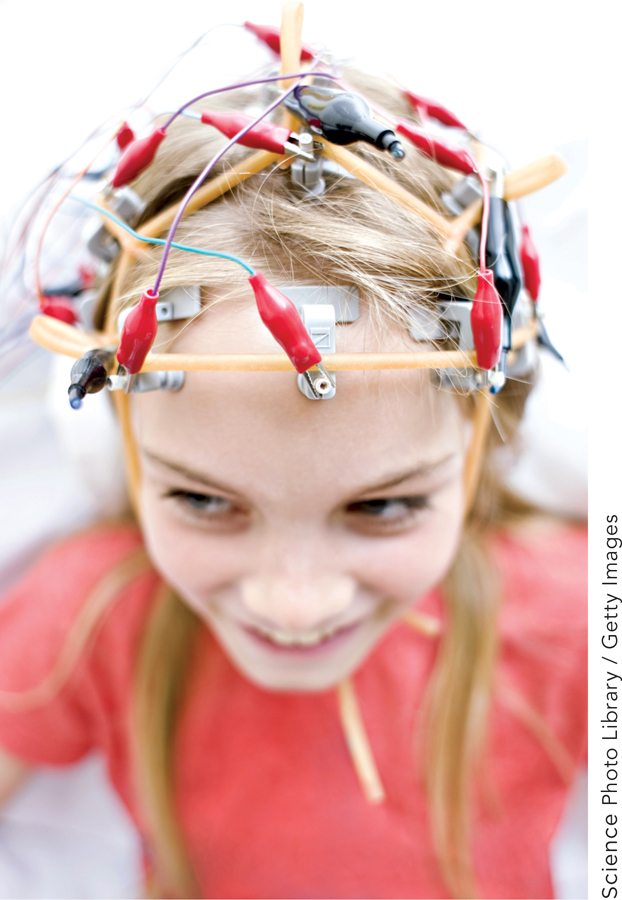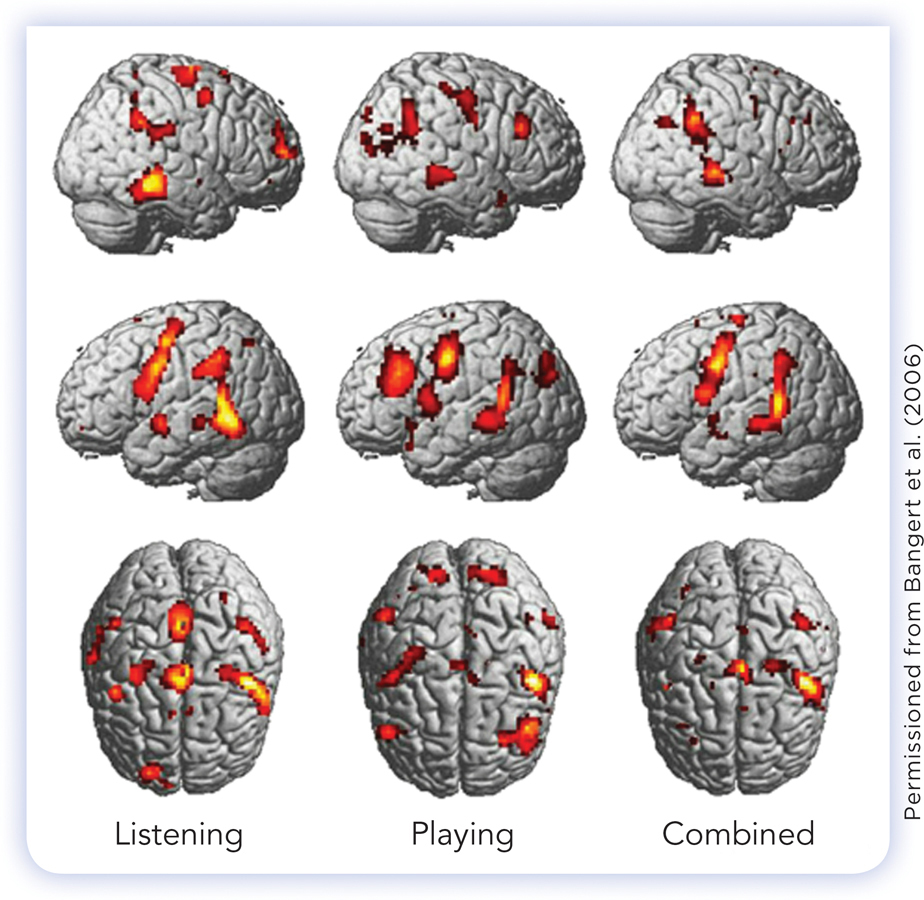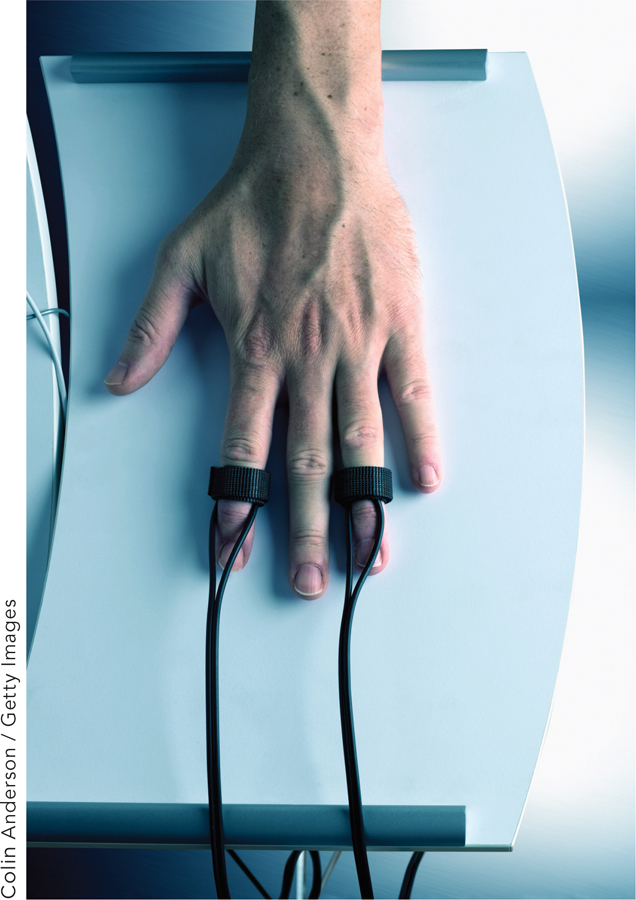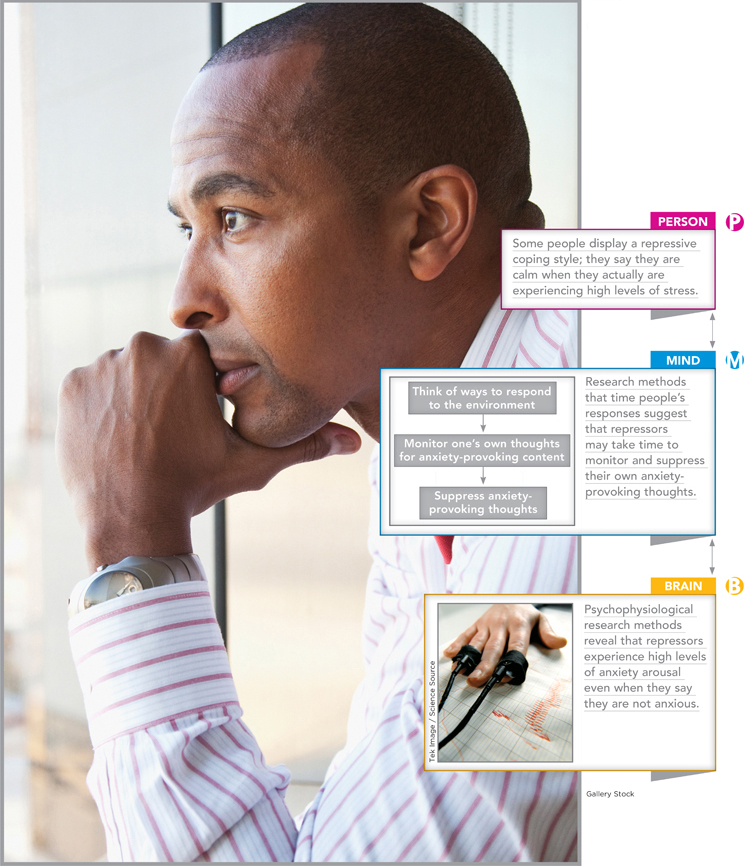2.4 Obtaining Scientific Evidence: Psychological and Biological
So far, you have learned about two main topics: data (qualitative and quantitative) and research designs (surveys, correlational studies, and experiments). We’re not done yet. Recall that the purpose of research is to obtain scientific evidence. To get it, scientists need specialized tools and procedures. A biologist needs a microscope and a procedure for obtaining permanent images of what it reveals. A subatomic physicist needs a particle accelerator and a way of detecting the particles that it produces.
What are the specialized tools and procedures of the psychologist? The answer depends on the type of evidence the psychologist is pursuing. We’ll review the ways in which psychologists obtain psychological evidence and biological evidence.
Psychological Evidence
Preview Questions
Question
 What are three forms of psychological evidence that researchers obtain to study people’s thoughts, feelings, and behaviors?
What are three forms of psychological evidence that researchers obtain to study people’s thoughts, feelings, and behaviors?
Question
 What are two limitations of self-
What are two limitations of self-
Psychological evidence is information about people’s thoughts, feelings, and behaviors. One source of such evidence is reports from the people themselves.
PARTICIPANTS AS INFORMANTS: SELF-
The most common self-
2.2
| Thought Record | |||||
|---|---|---|---|---|---|
|
Date/Time |
Situation |
Automatic Thought(s) |
Emotion(s) |
Adaptive Response |
Outcome |
|
|
|
|
|
|
|
|
4/28 5:12 p.m.
|
Stepped on the scale and it read 210; I have been trying to diet to get it down to 190. Sinking feeling in my stomach, tension in my shoulders
|
I am unattractive. 80% I really want to lose the weight, but it isn’t working. 95% I should be able to lose this weight. What’s wrong with me? 60%
|
Sad 40% Frustrated 30% Ashamed 50%
|
Selective abstraction Although I am a little overweight, there are still attractive things about me. 95% Childish fantasy Weight loss is about the control of calories and exercise and not about how much I want it. 90% Thinking in “shoulds” Weight loss is hard and it takes time to develop a plan that works and that you can stick to. 95%
|
Unattractive 40% Sad 20% I really want to 90% true, but relevance 10% Frustrated 10% I should 10% Ashamed 5% Plan: Revise my diet and increase exercise by going to the gym three days a week. |
|
From © J. Beck, 2011. Adapted from Cognitive Behavior Therapy: Basics and Beyond, 2nd edition, and used with permission. |
|||||
The Thought Record is an example of a self-
Sometimes people might not be able or willing to report accurately about themselves. This problem can be overcome by using observer reports, in which people describe the psychological characteristics of individuals they know. Parents, for example, might be asked to report on their children. College students might be asked to report on the personalities of their roommates. Research shows that observer reports can provide unique information not obtained merely by asking people to describe themselves (Oltmanns & Turkheimer, 2009).
PARTICIPANTS OBSERVED: DIRECT OBSERVATIONS OF BEHAVIOR. Some argue that psychology’s reliance on self-
Can you remember what you did in the past week?
One alternative is direct observation of behavior, a form of evidence in which researchers view the actions of research participants firsthand and record the behaviors they observe. Typically, researchers develop a system for counting specific types of behavior that may occur when participants are observed. They then use this counting system to record participants’ behavior during the course of a study. For example, in the study described in our opening story, researchers directly observed, recorded, and counted the behaviors of men who had walked across a safe or frightening bridge.

Direct observation of behavior may reveal facts not unearthed in self-
PROBING THE MIND: LABORATORY TASKS THAT REVEAL MENTAL PROCESSES. As we discussed in Chapter 1, one aim of psychology is to understand the workings of the mind: the mental processes involved in memory, thought, and emotion. When searching for evidence about the mind, researchers face two challenges: Mental processes often cannot be observed (1) in someone else (if you look at a person, you can’t see what she is thinking about) or (2) in oneself (an idea might “pop into mind” without your being able to identify how it got there). A new form of evidence—
This third form of evidence is laboratory tasks that reveal mental processes. Researchers devise novel tasks on which performance requires a specific mental skill. They give these tasks to participants in controlled laboratory settings (i.e., settings in which participants are not distracted by everyday activities). By recording people’s performance on these tasks, researchers can gain insight into the workings of the mind. Here’s an example.
Many psychologists believe there are two different types of thinking processes, “fast” and “slow” (Kahneman, 2011). Fast thinking occurs automatically; you cannot stop it from happening. Slow thinking requires deliberate effort. How can one test this idea, given that thinking processes cannot be directly observed? If you attempted this chapter’s Try This! activity, you already know of one way to do so.
TRY THIS!
Earlier, we asked you to experience this chapter’s Try This! activity. If you didn’t do it then, try it now; it is on the Internet at www.pmbpsychology.com.
The Try This! activity was a specialized laboratory task called the Stroop Task (MacLeod & MacDonald, 2000; Stroop, 1935). As you saw, in the Stroop Task people are shown color names printed in different colors of ink (Figure 2.8). Sometimes the ink color and the named color correspond, but sometimes they do not. Participants must say, as quickly as possible, the color of the ink.

When the ink color and printed color name correspond, the task is easy. But when they conflict—
Now that you have tried the Stroop Task, ask yourself, “What does it say about how the mind works?” The Stroop Task shows that the mental processes involved in reading occur more quickly than the mental processes needed to name colors. This means that the mind works at different speeds, fast and slow.
WHAT DO YOU KNOW?…
Question 14
A laboratory task that reveals mental processes, such as the Stroop Task, does not rely on self-
Biological Evidence
Preview Question
Question
 What are two main targets for research in studies of psychology and biology, and how do scientists learn about them?
What are two main targets for research in studies of psychology and biology, and how do scientists learn about them?
In the past, the scientific evidence obtained in most areas of psychology was exclusively psychological. Biological evidence—
Why the big change? It was fueled by technological advances in neuroscience, the scientific field that studies the brain and nervous system (see Chapter 3). Only 20 years ago, neuroscientists “lamented science’s lack of even a basic understanding of human neuroanatomy,” but today, “novel technologies and automation … map neural circuitry with unparalleled resolution and completeness” (Perkel, 2013, p. 250). These advances have enabled psychologists to pursue a goal we discussed in Chapter 1: deepening their understanding of people and the mind by conducting research at the level of analysis of the brain. Here, we’ll briefly overview the equipment and procedures they use to do this.
EVIDENCE ABOUT THE BRAIN: EEG AND FMRI. Two types of activity occur in the brain. One is electrical and the other is chemical. Scientific evidence about the brain thus comes in two main varieties: electrical and chemical.
The brain’s electrical activity is generated by its individual cells, called neurons. Electrical impulses travel from one end of the neuron to the other. Electrical activity within the brain thus can be recorded by scientific equipment that is sensitive to electrical activity. Electroencephalography, or EEG, is a technique for recording the brain’s electrical activity by placing electrodes on the scalp. Each electrode records the amount of electrical activity occurring in the region of the brain nearest to it. The resulting recordings of electrical activity provide evidence of the amount of neural activity in different brain regions.

A second source of information about the brain’s electrical activity is indirect. Rather than recording electrical signals, researchers record blood flow. Like other cells in the body, the brain’s neurons need energy. Neurons that are more active—

The brain’s chemical activities involve its neurotransmitters, which are biochemical substances that travel from one neuron to another. When a neurotransmitter released by one neuron reaches a second neuron, it affects the activity of the second neuron. Neurons are thus said to “communicate” through neurotransmitters. Thanks to neurotransmitter activity, the brain contains networks of interconnected neurons that are in continuous communication.
In research, neurotransmitter activity can be manipulated by use of psychoactive substances, which are any chemical substances that affect psychological processes (e.g., perception, thinking, or emotion). Psychoactive substances exert their effects by altering the normal communications between neurons. In addition to their research use, psychoactive substances are widely used in therapies for people suffering from psychological disorders involving mood and emotion (see Chapter 15), as well as disorders involving severe alterations in the ability to accurately perceive and understand reality (see Chapter 16).
EVIDENCE ABOUT THE BODY: PSYCHOPHYSIOLOGY. If you’re about to give a public speech, your whole body reacts: You sweat, your heart beats faster, and you feel “worked up.” Psychophysiology is a field of study that provides scientific information about the relation between such physiological reactions and psychological experiences (Andreassi, 2007).
Psychophysiologists use specialized tools to record the activity levels of bodily systems. One is skin conductance response (SCR), a measure of electrical resistance at the skin (see photo). Skin conductance changes when sweat glands are active, which occurs when people are anxious. SCR thus provides a physiological measure of anxiety.
Another physiological measure is heart rate. Recordings made using heart rate monitors can detect changes in heart rate that occur as people perform different types of tasks.

Psychophysiological measures can yield information that goes beyond the information obtained in self-
Self-
report measures: Researchers asked participants to describe their typical level of anxiety in a self-report questionnaire. Physiological measures: Researchers obtained SCR and heart rate measures while participants performed a mildly stressful task in which they heard a phrase that was potentially anxiety provoking (e.g., “His roommate kicked him in the stomach”) and had to think of another phrase to complete the thought as quickly as possible.
On the self-
Interestingly, the researchers also measured how long it took participants to generate the phrases. Repressors, they found, took more time (Weinberger et al., 1979). Why would that be? One possibility is that, during the experimental task, repressors engaged in an extra step of information processing; they not only (1) thought of phrases to complete the idea they heard but, unlike others, also (2) monitored their own responses for potential anxiety-


What would an SCR reveal about your levels of anxiety right now?
WHAT DO YOU KNOW?…
Question 15
Neurons emit electrical activity, which can be detected with a technique called or EEG. Active neurons need more energy, which they get from oxygen in the blood; a technology that tracks blood flow in the brain, , can thus track neural activity. Neural activity can also be studied by manipulating neural communication via substances. The psychophysiological tool that measures (SCR) provides an operational definition of anxiety that does not rely on self-